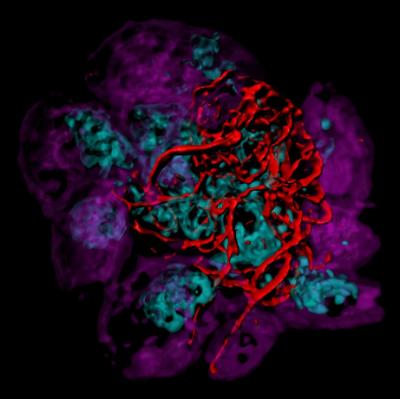New study on Toxoplasma gondii shows how parasites communicate inside the host cell
Published: 20 March 2017
Researchers at the WCMP and University of Vermont have identified an intracellular network in Toxoplasma parasites allowing them to communicate inside the host cell.
Toxoplasma gondii is a parasite that commonly infects cats but is also carried by other warm-blooded animals, including humans. Up to one-third of the UK population are chronically infected with the parasite, although most experience few harmful effects.
However, women who become infected during pregnancy can pass the parasite to their unborn child. This can result in serious health problems for the baby such as blindness and brain damage. People who have compromised immunity, such as individuals infected with HIV, are also at risk of serious complications owing to the reactivation of dormant parasitic cysts in the brain.
Toxoplasma parasites must actively invade host cells so they can replicate and survive. During an infection, this replication is synchronised, meaning that all parasites in the host cell replicate at the same time.
Until now it was unknown how parasites co-ordinated this tightly regulated process. The Meissner Group from the WCMP and researchers from the University of Vermont have discovered that a ‘cytoskeleton’ composed of the protein actin, within the parasite cells forms an extensive network that connects individual Toxoplasma parasites. When this protein is depleted in the parasite, not only does this network collapse, but the parasites also start to replicate asynchronously and are trapped inside the host cell.
While it is known that the protein actin readily form filaments in other organisms, they have not been seen in Toxoplasma before. Indeed, it was accepted amongst researchers that Toxoplasma doesn’t form filamentous actin. However, a novel tool was used to visualise this protein network, which is based on antibodies derived from camels (Chromobody®).
“When we first saw the formation of such an extensive network, we didn’t believe our eyes and the first thing we discussed was if this is just an artefact. However, at the end all our control experiments demonstrated that it is very real. The major challenge was to convince some of our colleagues who were also looking into the role of actin in these parasites.” said Prof Meissner from the WCMP, one of the lead authors of this study.
Apart from identifying novel functions of this important molecule, the research community now has another available tool to study the role of actin in other important parasites, such as Plasmodium falciparum, the causative agent for malaria. The findings could provide clues to new treatment for these diseases, which cause substantial morbidity and mortality worldwide.
The work has been published in the journal eLIFE and was funded by by Wellcome, and an ERC (European Research Council) Starting Grant.
Hear Professor Meissner talk about these findings in the eLIFE Podcast.

Intracellular Toxoplasma parasites (purple) form an extensive network consisting of actin filaments (red) that connects each individual parasite. This network is used to exchange material between the parasites. The parasite nucleus is stained in blue (image: Dr Leandro Lemgruber).
First published: 20 March 2017
<< Centre News

